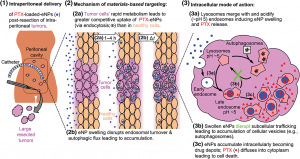August 31, 2017
Nanoparticle (NP)-based drug-delivery systems are frequently employed to improve the intravenous administration of chemotherapy; however, few reports explore their application as an intraperitoneal therapy. We developed a pH-responsive expansile nanoparticle (eNP) specifically designed to leverage the intraperitoneal route of administration to treat intraperitoneal malignancies, such as mesothelioma, ovarian, and pancreatic carcinomatoses. This review describes the design, evaluation, and evolution of the eNP technology and, specifically, a Materials-Based Targeting paradigm that is unique among the many active- and passive-targeting strategies currently employed by NP-delivery systems. pH-responsive eNP swelling is responsible for the extended residence at the target tumor site as well as the subsequent improvement in tumoral drug delivery and efficacy observed with paclitaxel-loaded eNPs (PTX-eNPs) compared to the standard clinical formulation of paclitaxel, Taxol®. Superior PTX-eNP efficacy is demonstrated in two different orthotopic models of peritoneal cancer—mesothelioma and ovarian cancer; in a third model—of pancreatic cancer—PTX-eNPs demonstrated comparable efficacy to Taxol with reduced toxicity. Furthermore, the unique structural and responsive characteristics of eNPs enable them to be used in three additional treatment paradigms, including: treatment of lymphatic metastases in breast cancer; use as a highly fluorescent probe to visually guide the resection of peritoneal implants; and, in a two-step delivery paradigm for concentrating separately administered NP and drug at a target site. This case study serves as an important example of using the targeted disease-state’s pathophysiology to inform the NP design as well as the method of use of the delivery system.
Nanoparticle Drug-Delivery Systems for Peritoneal Cancers: A Case Study of the Design, Characterization and Development of the Expansile Nanoparticle.
Aaron H. Colby, Nicholas H. Oberlies, Cedric J. Pearce, Victoria L. M. Herrera, Yolonda L. Colson, and Mark W. Grinstaff
Wiley Interdisciplinary Reviews: Nanomedicine and Nanobiotechnology, 2017, 9, e1451-n/a.
PMID: 28185434; PMCID: PMC5389910; doi: 10.1002/wnan.1451
